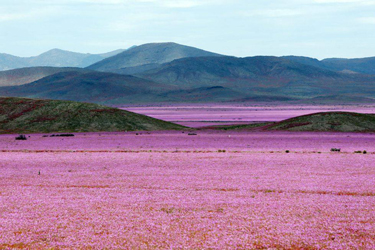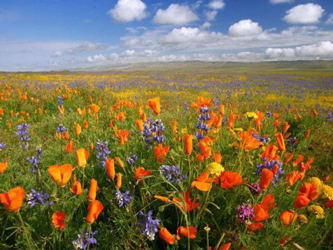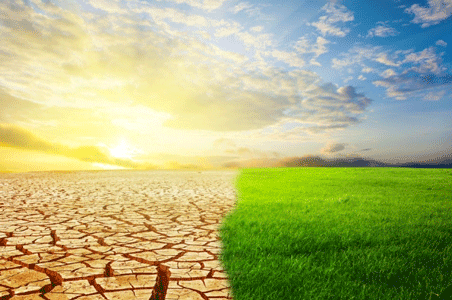Milieuzaken.org
feiten, getallen en opinies.
De Grootste woestijnen ter wereld:
Sahara: 9.064.692 km2
Arabische Woestijn: 2.589.989 km2
Gobi Woestijn: 1.294.994 km2
Patagonian Woestijn: 673.397 km2
Grote Victoria Woestijn: 647.497 km2
Rub'al Khali: 647.497 km2
Kalahari: 582.747 km2
(bron: "Weetjes over de aarde", d.d. 24-1-2009).
Ter vergelijking: Nederland
heeft een oppervlakte van ruim 41.526 km2
Chili:

klik voore een vergroting |
|
Atacama-woestijn, de droogste plek op aarde.
Maar als het heel af en toe eens flink regent, dan krijg je o.a. dit, zoals in 2015
zie voor veel meer schitterende bloemen-foto's het foto-album op facebook van Fernando Barrantes Rodríguez-Larrain |
De Washington Post schreef er op 29 okt 2015 het volgende over:
The Atacama Desert in Chile, known as the driest place on Earth, is awash with color after a year’s worth of extreme rainfall.
In an average year, this desert is a very dry place. Arica, Chile, in the northern Atacama holds the world record for the longest dry streak, having gone 173 months without a drop of rain in the early 20th century. In another Atacama neighbor to the south of Arica, the average annual rainfall in the city of Antofagasta is just 0.07 inches.
But strong El Niño years can be a rainy boom for the region, located just to the east of the warmest ocean water on the globe. In March 2015, heavy thunderstorms brought 0.96 inches of rain in one day to parts of the Atacama Desert. This doesn’t seem like that much, but it was a huge rainfall event for the desert — over 14 years of rain in one day. The torrent caused the typically dry Copiapo River to swell far beyond its banks. Flooding killed at least nine people that day.
As El Niño strengthens, so does the rainfall increases across South America. As areas of low pressure swing east into the Andes Mountains, the usually warm waters off the coast provide more than enough water vapor to fuel extreme rainfall events.
The malva (or mallow) flowers on the floor of the Atacama desert bloom every five to seven years, usually coinciding with El Nino. But they have been taking advantage of this year’s particularly rainy conditions, leading to the “most spectacular blossoming of the past 18 years.”

klik voor een vergroting
Israël
Israel bestaat voor meer dan 50 procent uit woestijn. Het Joods Nationaal Fonds zet zich in voor herbebossing in Israël, waaronder in de woestijnen. Lees hier meer over

klik voor vergroting
Sahara woestijn
Op Climategate.nl van 26-2-2019 verwijst, in de commentaren, ene MP naar een nieuwe MIT studie naar woestijnzand:
A “pacemaker” for North African climate; Study shows the Sahara swung between lush and desert conditions every 20,000 years, in sync with monsoon activity.
--------------------------------------------------> image: MIT News |
|
 |
Die studie toont aan dat de Sahara een cyclus heeft van 20.000 jaar nat klimaat en 20.000 jaar droog klimaat. Voorheen dachten wetenschappers dat Sahara woestijnvorming komt door de ijstijd cyclus..Groene Sahara met ijstijden en woestijn in warmere periodes, maar dat blijkt niet te kloppen. Het heeft te maken met de tilt van de aarde en omloopbaan rond de zon. Meer zon radiatie in die regio zorgt voor meer verdamping van zeewater en voor Moesson regenval condities, en andersom. Dus, mocht de CAGW theorie kloppen, dan heeft dat een positief/vergroenend effect op de Sahara woestijn. Zie hier als bovenstaande links zijn verbroken.
Deze website is een activiteit van dr. Hugo H. van der Molen, Copyright 2007 e.v.
Mail ons uw commentaar, aanvullingenen en correcties !
en Facebook of Linkedin



